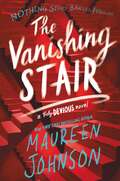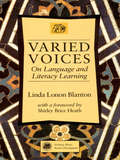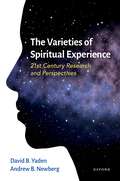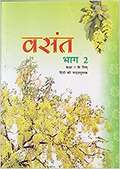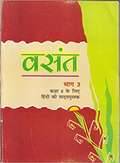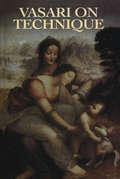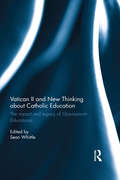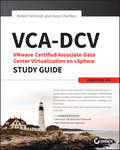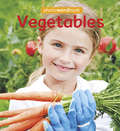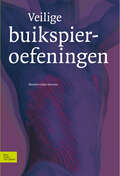- Table View
- List View
Vandalismus an Schulen: Bedeutungsstrukturen maskierender Raumpraktiken
by Ina HerrmannKritzeleien und Graffiti werden alltagstheoretisch als Vandalismus und somit als grundlegend negativ konnotierte Ausdrucksformen bezeichnet. Jedoch lassen sich vandalistische Praktiken als akteursseitige 'Gebrauchsspuren' oder ‚Inbesitznahmen‘ lesen, die im Rahmen dieser Studie als manifester Bestandteil einer Schularchitektur rekonstruiert werden. Vor dem raumtheoretischen Hintergrund sind die latenten Bedeutungsstrukturen der sog. Maskierungen des Schulraums zu verorten und hinsichtlich der Frage nach inhärenten Bildungspotentialen zu diskutieren.
The Vanishing Stair (Truly Devious Ser. #2)
by Maureen JohnsonThe Truly Devious case—an unsolved kidnapping and triple murder that rocked Ellingham Academy in 1936—has consumed Stevie for years. It’s the very reason she came to the academy. But then her classmate was murdered, and her parents quickly pull her out of school. For her safety, they say. She must move past this obsession with crime. Stevie’s willing to do anything to get back to Ellingham, be back with her friends, and solve the Truly Devious case. Even if it means making a deal with the despicable Senator Edward King. And when Stevie finally returns, she also returns to David: the guy she kissed, and the guy who lied about his identity—Edward King’s son. But larger issues are at play. Where did the murderer hide? What’s the meaning of the riddle Albert Ellingham left behind? And what, exactly, is at stake in the Truly Devious affair? The Ellingham case isn’t just a piece of history—it’s a live wire into the present.
Varied Voices: On Language and Literacy Learning
by Linda Lonon Blanton"I can say with certainty that this book will add a compelling sense of depth and texture to the existing body of research in first and second language literacy." --Patricia Richard-Amato, California State University at Los Angeles Varied Voices is an ethnographic study of language and literacy learning in a culturally and linguistically diverse Moroccan school. There, children and teachers turn classrooms into social spaces as they work to build learning communities. Suitable for MATESOL courses and in-service training, Varied Voices is a must-read for all instructors working with language minority students at the elementary and secondary school levels.
Varied Voices: On Language and Literacy Learning
by Linda Lonon Blanton"I can say with certainty that this book will add a compelling sense of depth and texture to the existing body of research in first and second language literacy." --Patricia Richard-Amato, California State University at Los Angeles Varied Voices is an ethnographic study of language and literacy learning in a culturally and linguistically diverse Moroccan school. There, children and teachers turn classrooms into social spaces as they work to build learning communities. Suitable for MATESOL courses and in-service training, Varied Voices is a must-read for all instructors working with language minority students at the elementary and secondary school levels.
Varieties of Female Gothic Vol 5
by Gary KellyThis text offers scholarly and critical editions of significant novels of Gothic fiction from the Romantic period. It illustrates the various forms of female Gothic literature as a vehicle for representing the modern forms of subjectivity, or complex and authentic inward experience and identity.
Varieties of Female Gothic Vol 5
by Gary KellyThis text offers scholarly and critical editions of significant novels of Gothic fiction from the Romantic period. It illustrates the various forms of female Gothic literature as a vehicle for representing the modern forms of subjectivity, or complex and authentic inward experience and identity.
Varieties of Qualitative Research Methods: Selected Contextual Perspectives (Springer Texts in Education)
by Janet Mola Okoko Scott Tunison Keith D. WalkerThis book is a compilation of more than 70 qualitative research concepts that are used by researchers and practitioners in the social sciences and humanities. The concepts include methods and methodologies applied in qualitative research in various contexts. Each concept is a standalone chapter that is authored by a researcher or practitioner who has had some scholarly experience with it. The chapters are alphabetized using the titles of the concepts to provide easy access for readers. They follow a prescribed outline which ensures homogeneity in the layout of the book. Each chapter starts with a brief historical background of the concept, followed by a concise description of the concept, and the process used in its application. Readers are then provided with the possible ways in which the concept can be used, and its benefits. Each chapter concludes by providing readers with some strengths and limitations of the concept and a list of references that authors have used in the chapter.
The Varieties of Spiritual Experience: 21st Century Research and Perspectives
by Andrew Newberg David B. YadenA cutting-edge guide to the psychology and neuroscience of spiritual experiences Spiritual experiences have occurred within people around the world and throughout history, up to and including the present day. The founders of every major religion described them, philosophers since antiquity have pondered them, and according to recent polls, about 30% of people still report them. A century ago, philosopher and psychologist William James famously analyzed accounts of these experiences and raised questions for future scientific study. What triggers these events? How are the brain and body affected? How do these brief moments have such lasting effects? Now, modern science has some answers. This book invites readers into contemporary psychology and neuroscience laboratories around the world to learn about these elusive yet profound inner events. As it explores phenomena ranging from divine revelations to paranormal experiences to life-changing experiences of unity, findings from modern science are illustrated with a diverse set of personal accounts from believers and non-believers alike, plunging readers into deeply personal and sometimes transformative moments. Written by two renowned scientists in the field, this book is a deep exploration of the psychology and neuroscience of a range of profoundly meaningful experiences.
The Varieties of Spiritual Experience: 21st Century Research and Perspectives
by David B. Yaden Andrew NewbergA cutting-edge guide to the psychology and neuroscience of spiritual experiences Spiritual experiences have occurred within people around the world and throughout history, up to and including the present day. The founders of every major religion described them, philosophers since antiquity have pondered them, and according to recent polls, about 30% of people still report them. A century ago, philosopher and psychologist William James famously analyzed accounts of these experiences and raised questions for future scientific study. What triggers these events? How are the brain and body affected? How do these brief moments have such lasting effects? Now, modern science has some answers. This book invites readers into contemporary psychology and neuroscience laboratories around the world to learn about these elusive yet profound inner events. As it explores phenomena ranging from divine revelations to paranormal experiences to life-changing experiences of unity, findings from modern science are illustrated with a diverse set of personal accounts from believers and non-believers alike, plunging readers into deeply personal and sometimes transformative moments. Written by two renowned scientists in the field, this book is a deep exploration of the psychology and neuroscience of a range of profoundly meaningful experiences.
The Varnish and the Glaze: Painting Splendor with Oil, 1100–1500
by Marjolijn BolA new history of the techniques, materials, and aesthetic ambitions that gave rise to the radiant verisimilitude of Jan van Eyck’s oil paintings on panel. Panel painters in both the middle ages and the fifteenth century created works that evoke the luster of precious stones, the sheen of polished gold and silver, and the colorful radiance of stained glass. Yet their approaches to rendering these materials were markedly different. Marjolijn Bol explores some of the reasons behind this radical transformation by telling the history of the two oil painting techniques used to depict everything that glistens and glows—varnish and glaze. For more than a century after his death, the fifteenth-century painter Jan van Eyck was widely credited with inventing varnish and oil paint, on account of his unique visual realism. Once this was revealed to be a myth, the verisimilitude of his work was attributed instead to a new translucent painting technique: the glaze. Today, most theories about how Van Eyck achieved this realism revolve around the idea that he was the first to discover or refine the glazing technique. Bol, however, argues that, rather than being a fifteenth-century refinement, varnishing and glazing began centuries before. Drawing from an extensive body of recipes, Bol pieces together how varnishes and glazes were first developed as part of the medieval art of material mimesis. Artisans embellished metalwork and wood with varnishes and glazes to imitate gold and gems; infused rock crystal with oil, resin, and colorants to imitate more precious minerals; and oiled parchment to transform it into the appearance of green glass. Likewise, medieval panel painters used varnishes and glazes to create the look of enamel, silk, and more. The explorations of materials and their optical properties by these artists stimulated natural philosophers to come up with theories about transparent and translucent materials produced by the earth. Natural historians, influenced by medieval artists’ understanding of refraction and reflection, developed theories about gems, their creation, and their optical qualities.
The Varnish and the Glaze: Painting Splendor with Oil, 1100–1500
by Marjolijn BolA new history of the techniques, materials, and aesthetic ambitions that gave rise to the radiant verisimilitude of Jan van Eyck’s oil paintings on panel. Panel painters in both the middle ages and the fifteenth century created works that evoke the luster of precious stones, the sheen of polished gold and silver, and the colorful radiance of stained glass. Yet their approaches to rendering these materials were markedly different. Marjolijn Bol explores some of the reasons behind this radical transformation by telling the history of the two oil painting techniques used to depict everything that glistens and glows—varnish and glaze. For more than a century after his death, the fifteenth-century painter Jan van Eyck was widely credited with inventing varnish and oil paint, on account of his unique visual realism. Once this was revealed to be a myth, the verisimilitude of his work was attributed instead to a new translucent painting technique: the glaze. Today, most theories about how Van Eyck achieved this realism revolve around the idea that he was the first to discover or refine the glazing technique. Bol, however, argues that, rather than being a fifteenth-century refinement, varnishing and glazing began centuries before. Drawing from an extensive body of recipes, Bol pieces together how varnishes and glazes were first developed as part of the medieval art of material mimesis. Artisans embellished metalwork and wood with varnishes and glazes to imitate gold and gems; infused rock crystal with oil, resin, and colorants to imitate more precious minerals; and oiled parchment to transform it into the appearance of green glass. Likewise, medieval panel painters used varnishes and glazes to create the look of enamel, silk, and more. The explorations of materials and their optical properties by these artists stimulated natural philosophers to come up with theories about transparent and translucent materials produced by the earth. Natural historians, influenced by medieval artists’ understanding of refraction and reflection, developed theories about gems, their creation, and their optical qualities.
Vasant Bhag 2 class 7 - NCERT: वसंत भाग 2 कक्षा 7 - एनसीईआरटी
by Rashtriy Shaikshik Anusandhan Aur Prashikshan Parishadयह पाठ्यपुस्तक राष्ट्रीय पाठ्यचर्या की रूपरेखा (2005) के आधार पर तैयार किए गए पाठ्यक्रम पर आधारित है। यह पारंपरिक भाषा-शिक्षण की कई सीमाओं से आगे जाती है। राष्ट्रीय पाठ्यचर्या की नयी रूपरेखा भाषा को विद्यार्थी के व्यक्तित्व का सबसे समृद्ध संसाधन मानते हुए उसे पाठ्यक्रम के हर विषय से जोड़कर देखती है। इस नाते पाठ्यसामग्री का चयन और अभ्यासों में विद्यार्थी के भाषायी विकास की समग्रता को ध्यान में रखा गया है। कई प्रश्न-अभ्यास भाषा शिक्षण की परिचित परिधि से बाहर जाकर प्रकृति, समाज, विज्ञान, इतिहास आदि में विद्यार्थी की जिज्ञासा को नए आयाम देते हैं। पाठ केंद्रित प्रश्नों को क्रमशः विस्तार देते हुए पाठ के आसपास के ज्ञान-क्षेत्रों को भी दूसरे प्रश्न-समूहों में साथ रखने का प्रयास किया गया है। भाषा की बात करते हुए ऐसे शब्दों और प्रयोगों पर विद्यार्थी का ध्यान दिलाया गया है जिन्हें समाज की जीवंतता को साहित्यिक कृतियों में समेटते हुए साहित्यकार अपनी कृति में रखना आवश्यक समझते हैं और अकसर ऐसे आंचलिक शब्द और वाक्य प्रयोग आज के शहरी जीवन में अपेक्षाकृत कम सुनाई पड़ते हैं।
Vasant Bhag 3 class 8 - NCERT: वसंत भाग 3 कक्षा 8 - एनसीईआरटी
by Rashtriy Shaikshik Anusandhan Aur Prashikshan Parishadकक्षा 8 के लिए हिंदी की पाठ्यपुस्तक, एन.सी.ई.आर.टी. इस पुस्तक की रचना के लिए बनाई गई पाठ्यपुस्तक निर्माण समिति के परिश्रम के लिए कृतज्ञता व्यक्त करती है। परिषद् भाषा सलाहकार समिति के अध्यक्ष प्रोफ़ेसर नामवर सिंह और इस पुस्तक के मुख्य सलाहकार प्रोफ़ेसर पुरुषोत्तम अग्रवाल की विशेष आभारी है। इस पाठ्यपुस्तक के विकास में कई शिक्षकों ने योगदान किया, इस योगदान को संभव बनाने के लिए हम उनके प्राचार्यों के आभारी हैं। हम उन सभी संस्थाओं और संगठनों के प्रति कृतज्ञ हैं जिन्होंने अपने संसाधनों, सामग्री तथा सहयोगियों की मदद लेने में हमें उदारतापूर्वक सहयोग दिया। हम माध्यमिक एवं उच्च शिक्षा विभाग, मानव संसाधन विकास मंत्रालय द्वारा प्रोफ़ेसर मृणाल मीरी एवं प्रोफ़ेसर जी.पी. देशपांडे की अध्यक्षता में गठित निगरानी समिति (मॉनिटरिंग कमेटी) के सदस्यों को अपना मूल्यवान समय और सहयोग देने के लिए धन्यवाद देते हैं।
Vasari on Technique: Being The Introduction To The Three Arts Of Design, Architecture, Sculpture and Painting, Prefixed to the Lives of the Most Excellent Painters, Sculptors and Architects (Dover Art Instruction)
by Giorgio VasariGiorgio Vasari (1511–1571) is well known for his celebrated work on the lives of the Renaissance artists. But not many people know that Vasari was a painter and architect as well as a biographer, and that he wrote one of the most valuable treatises on the technical methods of the painters, architects, and sculptors of his time. This is the first and only English translation of this important technical material (originally published in 1550 as an introduction to Vasari's Lives of the Artists).Vasari, as a practical craftsman, brings to his work as unusual understanding of the processes and materials he writes about, and conveys this knowledge to the reader in a style of the pleasantest and most readable kind. In the section on architecture, he describes the methods used in constructing rustic fountains and grottos; how Michelangelo developed new uses for architectural materials; the architectural uses of enriched plaster; the Renaissance view of Ionic, Doric, Gothic, and other types of architecture; and many similar topics.In the selection on sculpture, the reader will learn about the making of the model, completion of the statue, reliefs, bronze casting, modelled plaster work, sculpture in wood, and other processes. The final section, on painting, discusses aesthetics, perspective, foreshortening, how colors were blended, fresco painting, painting in tempera, oil painting, and much more.Scholars and historians of art have long used this book as the most detailed and valuable sourcebook of its time. But its full, readable discussions, combined with the sense of actuality and historical presence it contains, make it also perhaps the best possible description of the Renaissance artists in the heyday of their achievement.
Väter im Abseits: Zum Kontaktabbruch der Vater-Kind-Beziehung nach Scheidung und Trennung
by Mariam Irene Tazi-Preve Olaf Kapella Markus Kaindl Doris Klepp Benedikt Krenn Monica Titton Setare Seyyed-HashemiDas Anliegen der vorliegenden Studie aus Österreich ist es, einen differenzierten Beitrag zur Komplexität der Beweggründe und Motivationen zu leisten, die zum Kontaktabbruch der Vater-Kind-Beziehung nach einer Scheidung oder Trennung führen.
Väter und ihre Söhne: Eine besondere Beziehung
by Alexander CherdronDas Buch widmet sich der Vater-Sohn-Beziehung – und zwar mit Blick auf jedermann; ebenso wie es Söhnen und Vätern anregende und aufschlussreiche Lektüre sein soll, können Psychotherapeuten und Berater mit Gewinn mitlesen. Nach einem historischen Abriss der Vater-Sohn-Beziehung wird deren Wandel im Laufe der Lebensphasen für beide Beteiligten und die Veränderung der Vaterrolle, insbesondere in der jüngeren Zeit hin zum soziologischen Terminus des „modernen Vaters“, beleuchtet. Auch aktuelle Ergebnisse der Väter-Forschung finden Beachtung. Aus tiefenpsychologischer Betrachtung werden klassische Konflikte der Vater-Sohn-Beziehung aufgezeigt und mit Fallbeispielen verdeutlicht. Das Spektrum ist breit und gut lesbar: vom „Normalen“, auch gesamt-gesellschaftlich Bedeutsamen (z. B. in der aktuellen Diskussionen um die sog. Generation Y) bis hin zu den oftmals tragischen unglücklichen Folgen, pathologisch ausgetragener Vater-Sohn-Konflikte.
Väter und ihre Söhne: Eine besondere Beziehung
by Alexander CherdronDieses Sachbuch widmet sich der Vater-Sohn-Beziehung – und zwar mit Blick auf jedermann; ebenso wie es Söhnen und Vätern (und Müttern) anregende und aufschlussreiche Lektüre sein soll, können Psychotherapeuten und Berater mit Gewinn mitlesen. Es werden zunächst Aspekte beleuchtet, die Vater-Werden, Mann-Sein und Sohn-Sein heute beinhalten. Anschließend wird der Wandel der Vater-Rolle und des Vater-Bildes, insbesondere in der jüngeren Zeit, dargestellt. Untermauert durch aktuelle Ergebnisse der Väter-Forschung wird die besondere Rolle des Vaters für die Entwicklung der Söhne erläutert. Hierbei werden phasenspezifische Entwicklungsschritte und das lebenslange Wechselspiel der Gefühlswelten zwischen beiden Beteiligten „einfühlbar“. Aus tiefenpsychologischer Betrachtung werden klassische Spannungsfelder zwischen Vätern und Söhnen aufgezeigt und an Hand von Fallbeispielen verdeutlicht. Gut lesbar wird hierbei das ganze Spektrum betrachtet: von der „normalen“ Entwicklung, auch in gesamtgesellschaftlichen Kontexten, bis hin zu den oftmals tragischen Folgen unglücklich verlaufender Vater-Sohn-Beziehungen. Aus dem Inhalt: Teil I Die Vater-Sohn-Beziehung in Geschichte und Gegenwart, soziologisch und psychoanalytisch betrachtet – Teil II Kommentierte Fallgeschichten. Der Autor: Dr. med. Alexander Cherdron ist Facharzt für Allgemeinmedizin, Psychotherapeut und Psychoanalytiker in eigener Praxis in Wiesbaden.
Väterforschung und Väterarbeit in der Migrationsgesellschaft: Rassismuskritische und intersektionale Perspektiven (Interkulturelle Studien)
by Michael TunçMichael Tunç untersucht, inwiefern sich Prozesse des Zusammenwirkens der Differenzlinien Geschlecht, Ethnizität und Klasse bei ethnisch minorisierten Vätern/Vätern of Color (PoC) rekonstruieren lassen. Der Autor präsentiert aktuelle Begriffe, Ansätze und Ergebnisse der Männlichkeits- und Väterlichkeitsforschung. Für emanzipative Entwicklungen arbeitet er den Begriff der progressiven Männlichkeit aus, mit dem sich Spannungen zwischen hegemonialen und progressiven Deutungsmustern von Männlichkeit/Väterlichkeit migrantischer Männer/PoC angemessen analysieren lassen. Er stellt intersektionale rassismuskritisch-migrationsgesellschaftliche Ansätze vor und überträgt sie auf diversitätsbewusste Väterarbeit.
Vaterschaft in Regenbogenfamilien: Eine Fallstudie zur Familiengestaltung und Elternpraxis homosexueller Männer (Familienforschung)
by Christian SagertChristian Sagert geht in diesem Buch der Frage auf den Grund, wie Väter ihre Lebenspraxis in gemeinsam realisierten Regenbogenfamilien gestalten, in denen eine normativ idealisierte Mutterrolle vermeintlich nicht existiert. Die qualitative Studie legt den Fokus erstmals auf Männerpaare, die den Wunsch nach Familiengründung fern von heterosexuellen Gründungszusammenhängen realisiert haben und macht dabei deutlich, welche Wirkungsmacht heteronormative Gesellschaftsstrukturen gerade für diese Familien entfalten. Daneben wird ein ausführlicher Überblick über die Lebenssituationen dieser Familien in Deutschland geboten: So werden u.a. die verschiedenen Entstehungszusammenhänge, die rechtliche Rahmung sowie Heteronormativität und Stigmata herausgestellt.
Vatican II and New Thinking about Catholic Education: The impact and legacy of Gravissimum Educationis
by Sean WhittleIt is only in the years since Vatican II that the new thinking about Catholic education has crystalised into shape. Vatican II and New Thinking about Catholic Education provides an opportune moment to take stock of the impact of Vatican II on Catholic education. This volume considers the various ways in which Vatican II and its teaching on education has been received and engages with the challenges and testing times that beset faith-based education in the twenty-first century. With insights from an international range of leading and influential advocates of Catholic education, the volume demonstrates the differing contexts of Catholic education and explores the ways in which Vatican II’s teaching on education has been received over the past four or five decades.
Vatican II and New Thinking about Catholic Education: The impact and legacy of Gravissimum Educationis
by Sean WhittleIt is only in the years since Vatican II that the new thinking about Catholic education has crystalised into shape. Vatican II and New Thinking about Catholic Education provides an opportune moment to take stock of the impact of Vatican II on Catholic education. This volume considers the various ways in which Vatican II and its teaching on education has been received and engages with the challenges and testing times that beset faith-based education in the twenty-first century. With insights from an international range of leading and influential advocates of Catholic education, the volume demonstrates the differing contexts of Catholic education and explores the ways in which Vatican II’s teaching on education has been received over the past four or five decades.
VCA-DCV VMware Certified Associate on vSphere Study Guide: VCAD-510
by Robert Schmidt Dane CharltonUse this expert guide to prepare for the VCA-DCV exam VCA-DCV VMware Certified Associate on vSphere Study Guide: VCAD-510 is a comprehensive study guide for the VMware Certified Associate – Data Center Virtualization exam. Hands-on examples, real-world scenarios, and expert review questions cover the full exam blueprint, and the companion website offers a suite of tools to help you prepare for the exam including practice exams, electronic flashcards, and a glossary of key terms. In addition, the website includes videos that demonstrate how to complete the more challenging tasks. Focused on practical skills, this study guide not only prepares you for the certification exam, but also for the duties expected of a VCA. The VMware Certified Associate-Data Center Virtualization certification targets those with limited virtualization and VMware data center technology experience, providing a springboard to the popular VMware Certified Professional-Data Center Virtualization certification. Virtualization has become a high priority among organizations, and credentialed professionals are in high demand. This guide helps you prove a certain level of foundational skill in basic virtualization technology, including the vSphere suite's Infrastructure Services, Application Services, and vCenter Server. Topics include: Explaining data center virtualization concepts Identifying the core components of vSphere Networking and storage planning/configuration with vSphere Correlating VMware solutions to common business challenges The VCA-DCV certification is the only one with no instructor-led training requirement, so a thorough study guide is an invaluable tool in you exam preparation. This book not only covers the full exam, but also provides practice designed to actually improve the skills used every day on the job. VCA-DCV VMware Certified Associate on vSphere Study Guide is more than just test prep—it's job prep.
VCA-DCV VMware Certified Associate on vSphere Study Guide: VCAD-510
by Robert Schmidt Dane CharltonUse this expert guide to prepare for the VCA-DCV exam VCA-DCV VMware Certified Associate on vSphere Study Guide: VCAD-510 is a comprehensive study guide for the VMware Certified Associate – Data Center Virtualization exam. Hands-on examples, real-world scenarios, and expert review questions cover the full exam blueprint, and the companion website offers a suite of tools to help you prepare for the exam including practice exams, electronic flashcards, and a glossary of key terms. In addition, the website includes videos that demonstrate how to complete the more challenging tasks. Focused on practical skills, this study guide not only prepares you for the certification exam, but also for the duties expected of a VCA. The VMware Certified Associate-Data Center Virtualization certification targets those with limited virtualization and VMware data center technology experience, providing a springboard to the popular VMware Certified Professional-Data Center Virtualization certification. Virtualization has become a high priority among organizations, and credentialed professionals are in high demand. This guide helps you prove a certain level of foundational skill in basic virtualization technology, including the vSphere suite's Infrastructure Services, Application Services, and vCenter Server. Topics include: Explaining data center virtualization concepts Identifying the core components of vSphere Networking and storage planning/configuration with vSphere Correlating VMware solutions to common business challenges The VCA-DCV certification is the only one with no instructor-led training requirement, so a thorough study guide is an invaluable tool in you exam preparation. This book not only covers the full exam, but also provides practice designed to actually improve the skills used every day on the job. VCA-DCV VMware Certified Associate on vSphere Study Guide is more than just test prep—it's job prep.
Vegetables: Vegetables (Photo Word Book #4)
by Camilla LloydPhoto word books are simple, non-fiction reading books to help establish vocabulary, basic grammar and comprehension alongside current reading schemes. Designed to bridge the gap between nursery and the national curriculum, these books will introduce emergent readers to curriculum topics in a charming and visually stimulating way.
Veilige buikspieroefeningen
by Blandine Calais-GermainMet grote regelmaat worden bij fitnessinstituten buikspieroefeningen gedaan. Meestal is dat om wat slanker te worden, een platte buik te behouden of een buikje kwijt te raken. Sterke buikspieren zijn op zich niet voldoende om een platte buik te krijgen. Het is niet zonder risico als we het accent leggen op de kracht ervan: door een onjuiste uitvoering van buikspieroefeningen kan er schade optreden aan de bekkenbodem, de buikwand of de tussenwervelschijven. Maar als de buikspieren te zwak zijn is het heel nuttig om ze te trainen.In Veilige buikspieroefeningen behandelt Blandine Calais-Germain een nieuw type buikspieroefeningen die rekening houden met de anatomische bouw van het lichaam. Bestaande opvattingen over buikspieroefeningen worden ter discussie gesteld. Veilige buikspieroefeningen behandelt de voorzorgsmaatregelen die genomen moeten worden bij de meest gebruikelijke buikspieroefeningen. Zo kan de beste manier gevonden worden om het gewenste resultaat te bereiken.

